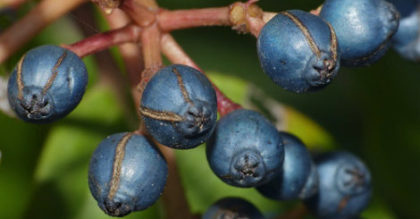
 )
)“Why is the sky blue?” is a perennial question of young children. It is also somewhat notorious for producing incorrect or incomplete answers, even from fairly credible sources. The typical answer for why ‘x’ is whatever color it is has to due with the wavelengths of light it absorbs. What we see is what is not absorbed but instead reflected, so if an object absorbs light from the red end of the spectrum it will look more blue, and vice versa. The sky appears blue for a different reason, though. Some white light from the sun not headed directly to our eyes gets deflected or scattered from its straight line path and gets redirected towards us; blue light is more easily redirected and so we see more of it than other colors. As it happens, there is still yet another way to look blue, and a common berry is the latest to be found using that route.
The general approach is called structural color. Instead of color arising from how individual molecules absorb light, it arises from the arrangements of molecules or larger structures and the way they reflect light. In this case, the cell walls in the outer layer of the Viburnum tinus berry are arranged to reflect blue light, almost like some sort of fun house mirror intended to make you look like a Smurf. The organization of the structure also means that the reflected light is polarized, or oriented in the same direction. This lends a metallic quality. The same principle gives the tail feathers of peacocks their metallic blue look also.
Particularly notable in this discovery is that fat globules in the cell well seem to be part of the relevant structures. These berries are rich in lipids, an important nutritional feature for animals that eat them. The authors therefore speculate that the dark blue color, which makes the berries stand out against the green leaves, is an honest signal of nutritional value. It is worthwhile to the berry plants, at a population level, to have birds take their seeds to germinate elsewhere. That cuts down on inbreeding in the berry population, by reducing the chances that adjacent plants–potential pollination partners–are siblings or other close relatives. In exchange, the bird gets useful nutrition. The honest part has to do with a direct relationship between the color and the nutritional content. Birds can’t burned by berries that look nutritious but aren’t because the color comes from the nutrition.
The logic of such honest signals is straightforward, akin to offering a quid pro quo. Yet not all signals between plants and animals are unambiguously honest. Perhaps the relevant selection pressures are not always strong enough to encourage a tight link between signal and nutrition, perhaps the right mutations aren’t there to select. And sometimes, the incentives may be more complex. Imagine another berry species which shares habitat with Viburnum tinus. The local birds associate dark blue berries with valuable nutrition. If this other berry plant can make dark blue berries with less of the valuable lipids, it can potentially get the same seed-spreading benefit but keep more lipids for itself or its offspring (inside the undigested seeds). All such honest systems are potentially susceptible to that kind of exploitation or subversion. At the same time, too much exploitation eliminates the advantage; too many non-nutritious blue berries and the birds no longer get an advantage from favoring them. The tragedy of the commons comes for all sorts of creatures.
Andy has worn many hats in his life. He knows this is a dreadfully clichéd notion, but since it is also literally true he uses it anyway. Among his current metaphorical hats: husband of one wife, father of two teenagers, reader of science fiction and science fact, enthusiast of contemporary symphonic music, and chief science officer. Previous metaphorical hats include: comp bio postdoc, molecular biology grad student, InterVarsity chapter president (that one came with a literal hat), music store clerk, house painter, and mosquito trapper. Among his more unique literal hats: British bobby, captain’s hats (of varying levels of authenticity) of several specific vessels, a deerstalker from 221B Baker St, and a railroad engineer’s cap. His monthly Science in Review is drawn from his weekly Science Corner posts — Wednesdays, 8am (Eastern) on the Emerging Scholars Network Blog. His book Faith across the Multiverse is available from Hendrickson.

Leave a Reply